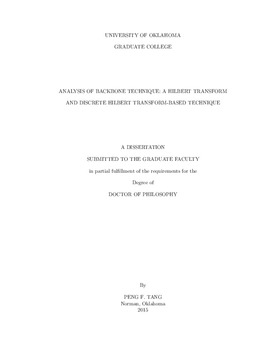| dc.description.abstract | This dissertation focuses on understanding and improving the “backbone” technique, a Hilbert-transform based vibration signal processing technique developed by Dr. Michael Feldman started in 1994. The concept of backbone seems straightforward being a mapping between the instantaneous amplitude and instantaneous frequency of vibration signals – mostly, free vibration signals of single-degree-of-freedom (SDOF) systems. Dr. Feldman shows a correlation between backbone pattern and the type of the underlying system nonlinearity. This motivated the utilization of the backbone as a pattern classifier for rapid system identification and damage detection. Nonetheless, unexpected “noisy” backbones – with oscillatory bodies and end(s) of these backbones – were obtained previously instead without an understanding of what caused and how to fix the problem that made the realization of the pattern classifier challenging. The author therefore was set to find out the reason and fix the problem; a theoretical approach would be taken whenever possible for a thorough understanding and remedy in a fundamental manner.
First, we pay attention to the discrete Hilbert transform (DHT) as we deal with real-world vibration signals that are, in general, finite and discrete. The end effect of DHT is investigated, after which a two-step preprocessing procedure is introduced. On one hand, theoretical justifications are provided for the preprocessing procedure. On the other hand, numerical simulation examples are provided to demonstrate the effectiveness in reducing end effect resulted from the procedure.
Unfortunately, even with the improved DHT procedure, we would still obtain “noisy” backbones. We thus contemplate with a couple of carefully designed doublecomponent signals. We show both theoretically and numerically that “noisy” backbones with oscillatory bodies and heads are supposed to occur in this and other multi-component signal. In the exploration of this phenomenon, we propose a concept named after “time index” to capture the interaction of the two mono-components that follow prescribed relations in their instantaneous quantities. By using this concept, we arrive at a signal decomposition method and correct a major integral formula in Dr. Feldman’s work.
The two-step preprocessing procedure for DHT and the time index-based signal decomposition method are then used to extract backbones of a series of Duffing oscillators, whose parameter values are designed so that these models mimic typical nonlinear SDOF systems in structural engineering, the focused application domain in this study. We perform a parametric study on the key parameters in these Duffing oscillators, which confirms the validity of the backbone technique. More importantly, we introduce the concept of instantaneous bandwidth to the backbone technique. By using instantaneous bandwidth, we quantify the relations among displacement, velocity and acceleration backbones in addition to other practical implementation issues.
Last but not least, the improved backbone technique is applied to a couple of real world data sets as the final tough test. Both promising results and technical challenges are reported in the thesis. With the accomplished theoretical and numerical investigation, this study lays a solid foundation for further advancing both digital signal processing and practical application aspects of this relatively new pattern classifier for many possible engineering applications. | en_US |
